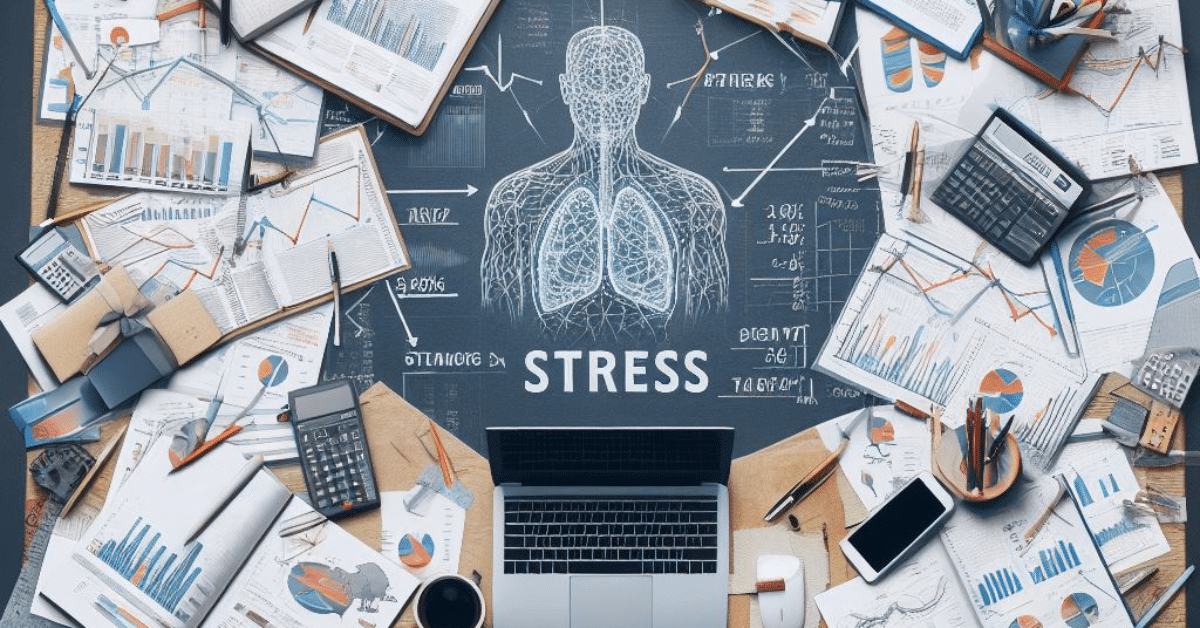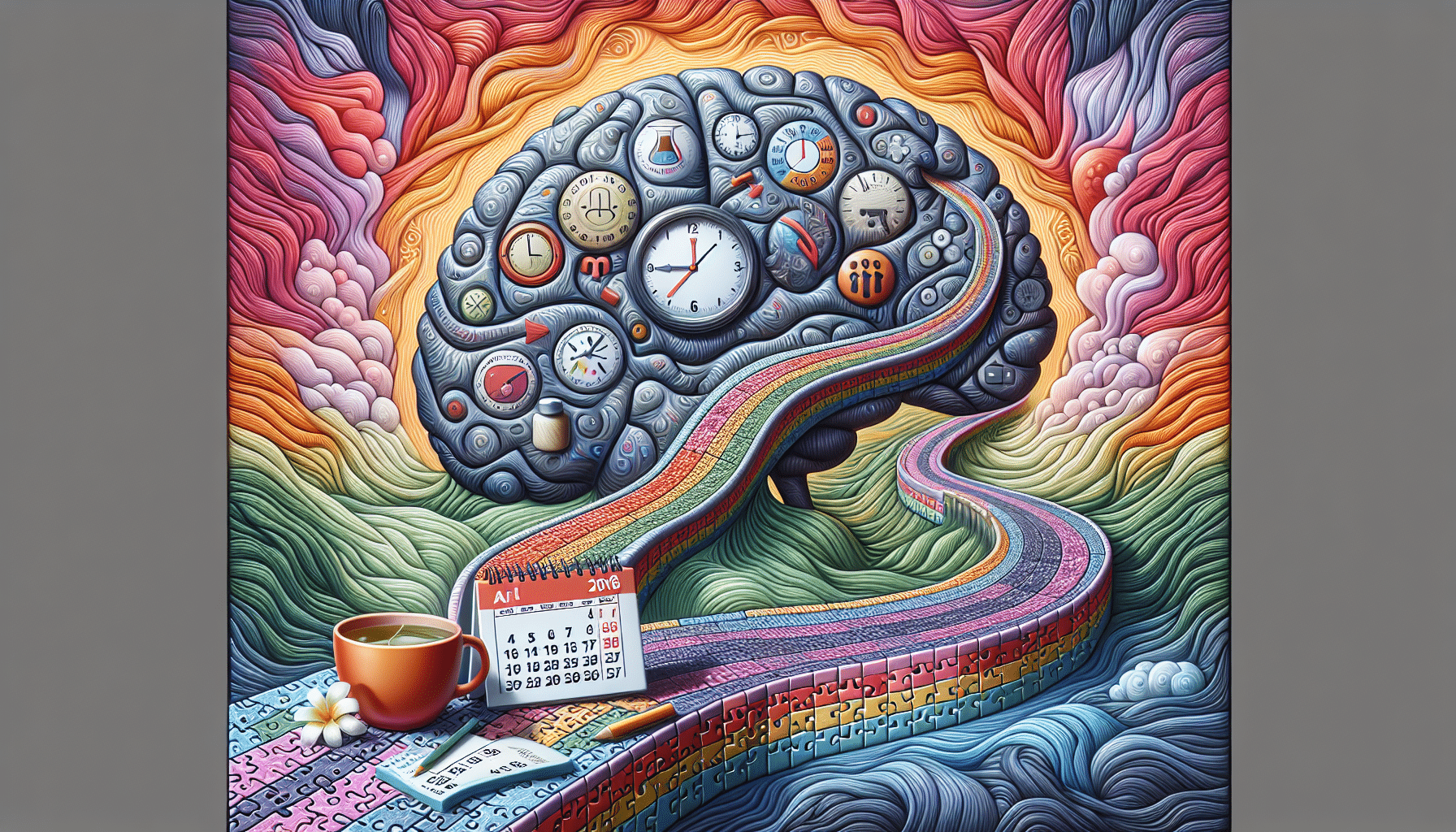This blog post aims to delve deep into stress statistics, shedding light on its multifaceted nature. To provide a more explicit depiction, we have incorporated a series of infographics that encapsulate vital data 1234, enabling a visual journey through the stress spectrum. As we navigate the statistics, we shall explore the prevalence of stress in the United States and globally, dissect its presence across various demographics and occupations, and unveil its economic and health implications.
Section 1: The Prevalence of Stress
Stress is a common disorder, often exacerbated by societal, economic, and geopolitical factors. Its prevalence and impact are felt both in the United States and across the globe, affecting individuals’ mental, emotional, and physical well-being.
Stress in the United States
Recent data paints a sad picture of the stress landscape in the United States. The nation is among the most stressed, with stress levels 20 percentage points higher than the global average. Remarkably, 55% of Americans reported feeling stressed during the day. Many factors contribute to this rising tide of stress, including economic pressures like inflation and healthcare costs, workplace stressors, and geopolitical tensions such as the crisis in Ukraine.
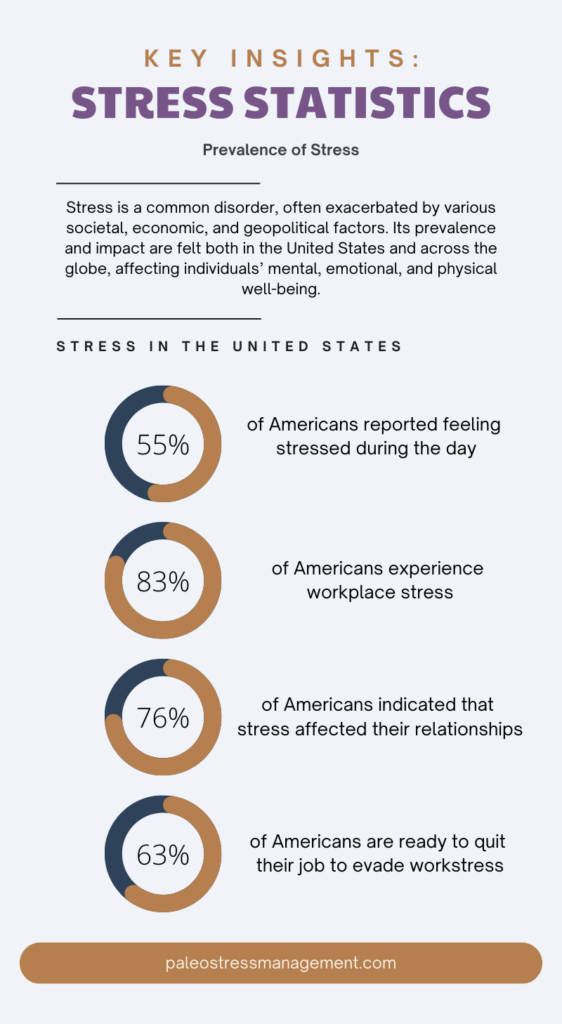
83% of Americans reported experiencing workplace stress. The ripple effects extend to personal relationships, with 76% indicating that workplace stress has negatively impacted their interpersonal relations. Moreover, 63% of US workers are ready to quit their jobs to evade work-related stress, showcasing the severe strain the working environment places on individuals.
Global Stress Levels
The global stress narrative echoes the trends observed in the U.S. Greece, for instance, reported the highest stress level at 59%, while globally, the average stress level across 143 countries stands at 35%.
The stress levels resonate through various countries with different intensities, reflecting a shared yet diverse human experience across borders. Stress remains a common denominator in the workplace, with other countries reporting varying levels of work-related stress. For instance, US and UK workers reported experiencing moderate stress 39% and 41% of the time, respectively.
Furthermore, the impact of stress transcends the workplace into personal and societal domains, affecting relationships and contributing to long-term health issues. Depression and anxiety, linked to stress, cost the global economy approximately $1 trillion in lost productivity, showcasing the economic toll of this pervasive issue.
Section 2: Causes and Sources of Stress
The multifaceted nature of stress triggers manifests through various channels, both personal and systemic, deeply ingrained in the societal fabric.
Causes of Stress in the United States
The causes of stress facing Americans are diverse and often interlinked. Economic pressures top the list, with 87% of adults citing the rise in everyday prices due to inflation as a significant stressor. Following closely are supply chain issues (81%), global uncertainty (81%), and geopolitical tensions such as Russia’s invasion of Ukraine (80%).
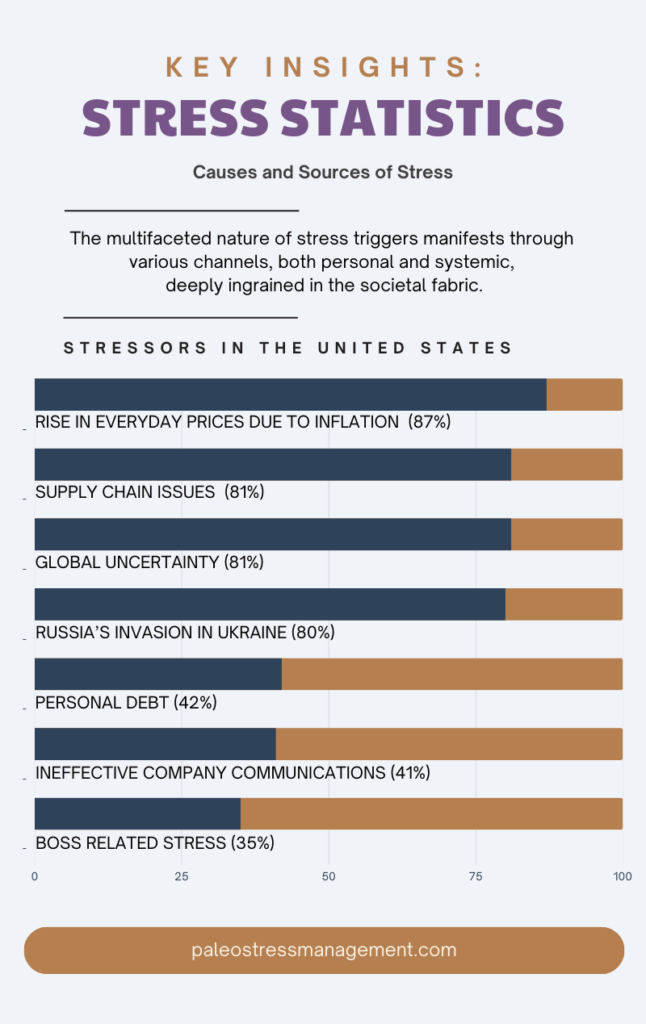
The workplace remains a hotbed for stress, with poor communication, workload, and ineffective company structures amplifying the stress levels. About 41% of US workers cite ineffective company communications as a cause of work stress, and 35% attribute their stress to their bosses.
Furthermore, personal and societal issues also weigh heavily on Americans. For instance, 42% of US adults cite personal debt as a significant source of stress, and mass shootings emerge as a notable stressor across all races, with 84% of Hispanics reporting this as the highest among the races.
Global Sources of Stress
Across the globe, similar themes emerge, albeit with regional variations. Living conditions, political climates, financial insecurity, and work issues are everyday stressors. In North America, 39% of employees report their workload as the primary source of work stress.
Comparatively, in countries like the UK, workplace stress, too, has a substantial economic cost, amounting to €20 billion in annual healthcare costs.
With its demanding schedules and often inadequate communication, the global work environment fosters a culture of stress that transcends geographical boundaries.
The diverse and often interconnected nature of stressors necessitates a holistic approach to understanding and addressing stress, fostering a global dialogue to mitigate its pervasive impact on individuals and societies.
Section 3: Demographic Insights into Stress
Examining stress from a demographic perspective within the United States reveals nuanced disparities among different groups. Age, gender, ethnicity, and socioeconomic status significantly influence how individuals experience and manage stress.
Age-Related Stress Trends

Younger age groups in the U.S. tend to report higher levels of stress, particularly those aged between 18 and 24. This age group often faces academic pressures, early career challenges, and societal expectations.
Comparatively, older individuals report lower stress levels, with 30% of older adults not feeling overwhelmed or unable to cope with stress symptoms, unlike younger adults, where only 7% express the same sentiments.
Gender Disparities in Stress
Gender significantly impacts stress experiences. Women generally rate their stress levels higher than men, with a self-rating stress survey showing women at 5.1 on a scale of 1-10 while men’s stress levels are at 4.4. Additionally, 36% of women report high levels of stress due to acceptance of physical appearance and body image, compared to 23% of men.
Ethnicity and Stress
Ethnicity also plays a role in stress prevalence. For instance, mass shootings are reported as a significant source of stress across all races, with 84% of Hispanic individuals reporting this, which is the highest among the races.
Additionally, 1 in 4 American adults mentions discrimination as a significant source of stress, highlighting the intersection of ethnicity and societal issues in stress experiences.
Socioeconomic Stress Dynamics
Socioeconomic status significantly contributes to stress levels. Financial insecurity, healthcare costs, and job-related stress are prevalent among individuals with lower socioeconomic status. For instance, 71% of U.S. adults with private health insurance and 53% with public insurance report the cost of healthcare as a stressor. Furthermore, 42% of U.S. adults cite personal debt as a significant source of stress.
Section 4: Work-Related Stress
The workplace is a significant source of stress for many Americans, impacting their professional lives, personal well-being, and overall health. The nuances of work-related stress are multifaceted, encompassing workload, communication issues, and managerial relationships.
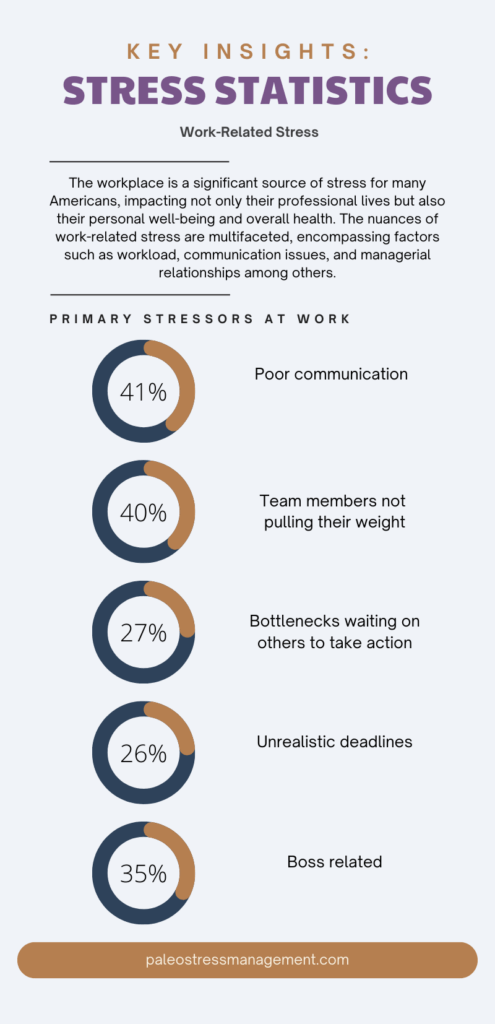
Prevalence of Workplace Stress
Work-related stress is highly prevalent in the U.S., with 83% of Americans experiencing workplace stress. This chronic stress in the workplace is associated with health complaints, often eclipsing stress from family problems and financial issues.
Primary Stressors at Work
Key stressors in the American workplace include poor communication, with 41% of workers identifying it as a source of stress, and team members not pulling their weight in projects (40%). Bottlenecks waiting on others to take action (27%), unrealistic deadlines (26%), and being overloaded (26%) also significantly contribute to work-related stress.
Additionally, managerial relationships play a crucial role, with 35% of workers attributing their workplace stress to their bosses.
Impact on Productivity and Employee Engagement
The ramifications of work-related stress extend to productivity and employee engagement. Stress and anxiety impact 56% of workers’ productivity, and 51% say it affects their relationships at work. Over 50% of U.S. workers are not mentally engaged during work due to stress, leading to low productivity. Furthermore, stress induces a weekly loss of over five hours of office work as employees ruminate over their stressors.
Burnout and Retention Challenges
The chronic nature of work-related stress triggers burnout, with one in four employees fearing they are at risk of burning out in the next 12 months. Moreover, 63% of U.S. workers are ready to quit to avoid work-related stress, signaling a significant retention challenge for organizations.
Section 5: Health Implications of Stress
The repercussions of chronic stress stretch far beyond temporary discomfort, encroaching on both physical and mental realms of health. The incessant demand that stress places on the body’s physiology can culminate into severe health issues over time.
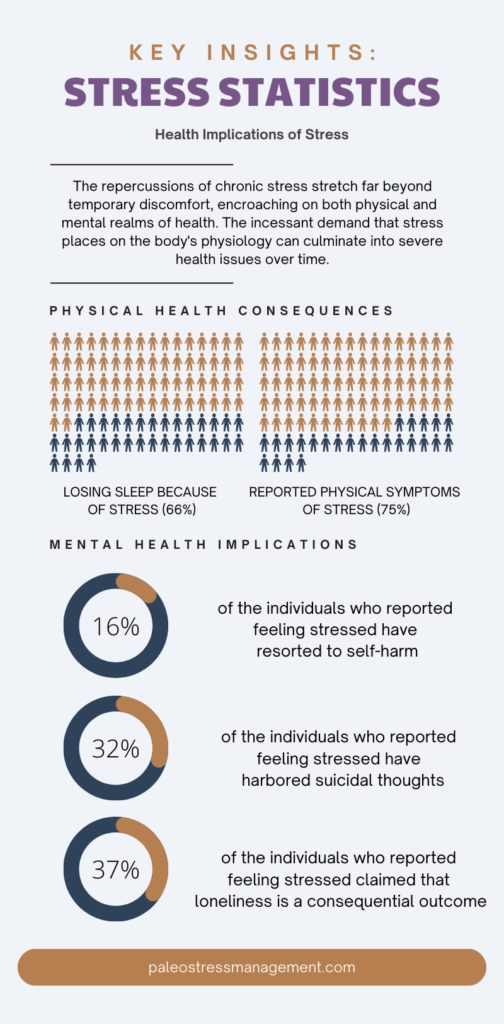
Physical Health Consequences
- Sleep Disorders: Stress, particularly from the workplace, has been associated with sleep disorders. About 66% of US workers reported losing sleep due to stress. The tossing and turning at night reflect an agitated mind unable to relax, disrupting the sleep cycle.
- Cardiovascular Health: Chronic stress is a precursor to hypertension and heart disease. The continuous release of stress hormones can elevate blood pressure levels and increase heart rate, potentially leading to cardiovascular diseases.
- Immune System Deterioration: Stress profoundly affects the immune system, making individuals more susceptible to infections and diseases.
- Other Physical Symptoms: Over 75% of US adults have reported physical symptoms of stress, including headaches and tiredness. Although these symptoms may seem trivial at the onset, they can significantly impair daily functioning and overall quality of life.
Mental Health Implications
- Depression and Anxiety: There’s a closely-knit relationship between stress and mental health disorders such as depression and anxiety. The prolonged exposure to stress can lead to cognitive deterioration, with depression being a significant concern.
- Self-harm and Suicidal Thoughts: Alarmingly, of the individuals who reported feeling stressed, 16% have resorted to self-harm, while 32% have harbored suicidal thoughts.
- Loneliness: About 37% of adults who reported stress claimed that loneliness is a consequential outcome. The feeling of isolation can further spiral into other mental health issues, creating a vicious cycle of emotional distress.
- Emotional Distress: The emotional turmoil accompanying stress is evident, with 47% of adults reporting losing patience or yelling due to stress and 45% lying awake at night. Emotional distress not only impairs interpersonal relationships but also sets a fertile ground for mental health disorders.
Section 6: Coping Strategies and Stress Management
Coping strategies and stress management techniques are vital in alleviating the adverse effects of stress and promoting mental and physical well-being. The data suggests various coping mechanisms employed by individuals facing stress, indicating a blend of self-care practices and external support.
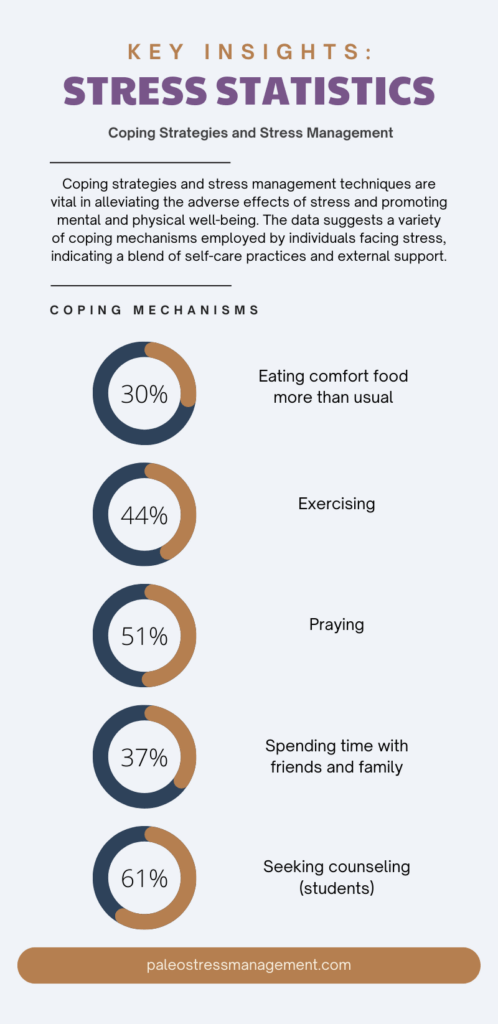
Self-Care Practices
Many US adults resort to self-care practices to mitigate stress, healthy or not. Around 30% of US adults consume comfort food “more than the usual” when facing stressful situations. Additionally, engaging in physical activities is a common coping strategy, with 44% of adults managing stress by exercising. These self-care practices provide a buffer against the deleterious effects of stress, albeit temporarily.
Spiritual and Social Support
Spiritual practices like prayer and meditation serve as a refuge for many amidst the storm of stress. Around 51% of US adults engage in prayer as a routine activity when faced with challenging or stressful situations. Social support, too, is crucial, with 37% of stressed individuals spending time with friends and family as a coping mechanism.
Professional Help and Therapy
Professional help, including counseling and therapy, is crucial in managing stress, especially when it’s persistent or severe. This is substantiated by the fact that 61% of college students seek counseling for anxiety, depression, academic performance, family issues, and relationship problems, indicating the recognition of professional help in stress management.
Workplace Stress Management Programs
Workplaces recognize the importance of addressing stress, with some offering stress management programs. These programs can benefit not only the employees but the company in the long run. However, there is room for improvement as only four out of 10 employees who report stress to their employers receive any help.
Section 7: Stress and Society
The ramifications of stress extend beyond the individual, reverberating through families, workplaces, and communities, thereby weaving a complex societal narrative.
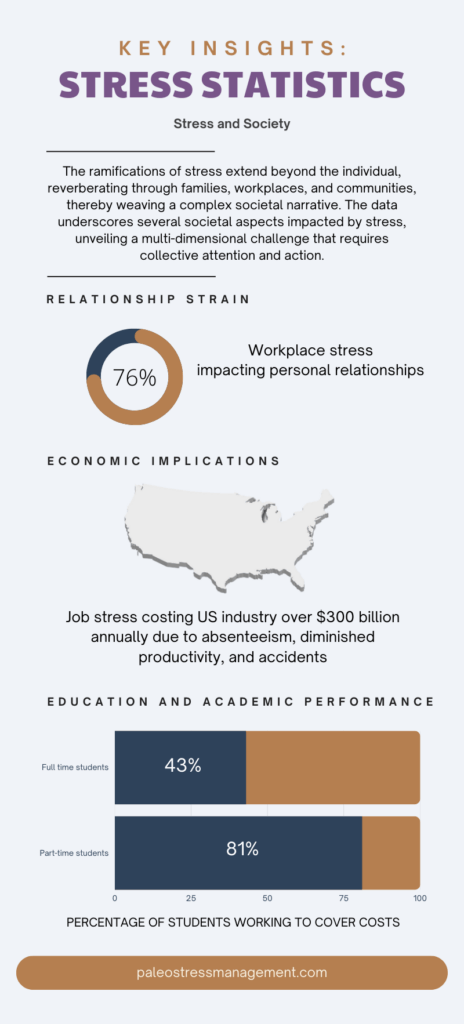
The data underscores several societal aspects impacted by stress, unveiling a multi-dimensional challenge that requires collective attention and action.
Relationship Strain and Social Cohesion
Stress tends to strain interpersonal relationships, with 76% of US workers reporting that workplace stress has adversely impacted their relationships. Moreover, the data depicts a concerning trend: 58% of US adults experienced a relationship strain or ended due to conflicts related to the COVID-19 pandemic. These figures elucidate the potential of stress to erode social cohesion and engender a climate of discord and isolation.
Economic Implications
The economic repercussions of stress are palpable. Job stress costs the US industry over $300 billion annually due to absenteeism, diminished productivity, and accidents. The stress-induced reduction in productivity also exacerbates the economic burden, as over five hours of office work are lost weekly to employees contemplating their stressors.
Education and Academic Performance
The academic arena is not immune to stress, with heavy workloads, poor sleep schedules, and insufficient downtime cited as everyday stressors among students. As university costs rise, 43% of full-time and 81% of part-time students work, reducing study and sleep hours. This financial burden adds another layer of stress to an already challenging academic environment.
Conclusion
Stress is an omnipresent aspect of human life, its tendrils reaching into myriad facets of our daily existence. As elucidated throughout this article, the pervasiveness of stress, its demographic dissections, work-related implications, health consequences, and societal impacts are substantial and multifaceted. The data presented underscores the magnitude and breadth of stress and beckons a call to action for individuals, communities, and organizations to prioritize stress management and mental health wellness.
The journey through the labyrinth of stress statistics offers a profound understanding of the deleterious effects of unmanaged stress and the imperative for adopting effective coping strategies. Whether fostering a supportive work environment, promoting mental health awareness, or embracing individual coping strategies, the steps towards managing stress and promoting mental health are crucial for enhancing the quality of life and well-being for individuals and society.
In closing, the expedition into stress statistics is not merely an academic endeavor but a societal imperative. This article aims to contribute to the broader dialogue on mental health and stress resilience by shedding light on the ubiquitous nature of stress and its extensive repercussions. It invites engaging in meaningful discussions, fostering awareness, and taking actionable steps toward a healthier, less stressful society.

